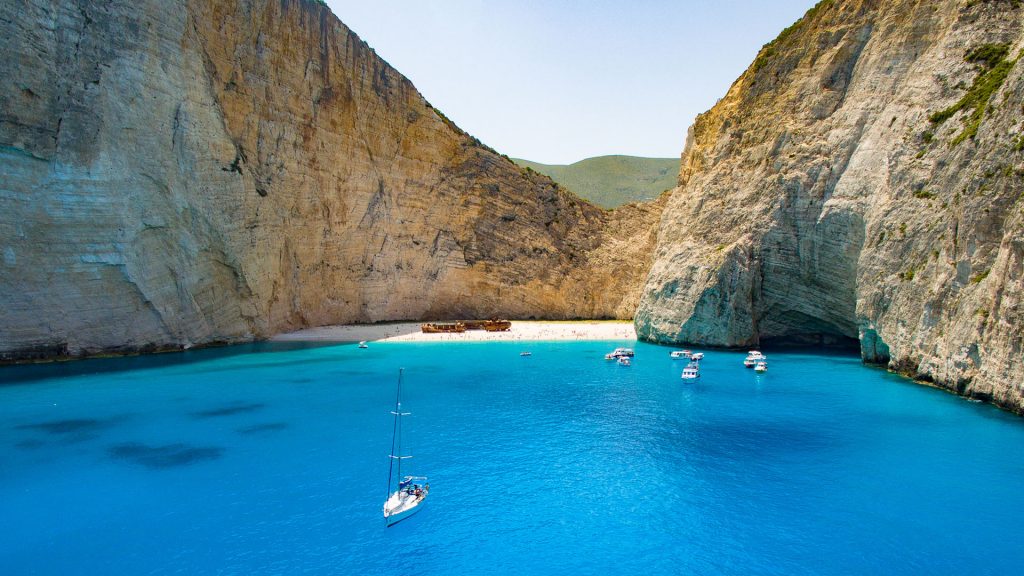About Zante
Zante, the flower of the East.
Zákynthos (Zante) is a green island endowed with fertile valleys, a mild climate, and a 123 km coastline.
Its landscape diversity has resulted in different types of beaches as there are sandy beaches in secluded coves where the tranquil waters are deep blue on the island’s southeastern part and others with rugged cliffs and an interesting underwater world to the western part of the island.
Historical
The Venetians, who ruled Zákynthos from 1484 to 1797, called the island “Fioro di Levante” (flower of the East) as there are over 7,000 species of flowers on Zákynthos. The third-largest island of the Ionian Sea, after Corfu and Kefaloniá, is internationally known as “Zante”. Zákynthos is said to have been the island’s first inhabitant and the ancient acropolis is attributed to him. He was the son of Dardanos who ruled the ancient kingdom of Frigia. A Venetian fort was built at later times on the site.
The Venetian architectural influence has left its stamp on Zante despite the damage sustained due to the seismic activity in the area. After the ravaging 1953 earthquake and the ensuing fire, a number of historical buildings and churches burned to the ground. Consequently, the significant treasures these buildings were housing perished. The town was rebuilt according to a plan where strict anti-seismic specifications applied and, to a large extent, respecting the town’s former architectural structure.
On Zante, great care is taken to protect two endangered animal species, namely the Caretta Caretta sea turtle and the monachus monachus seal.
The city of Zakynthos is the capital of the island and at the same time the island’s port.
Interesting sights around the city to visit
- The Solomos Square surrounded by buildings with characteristic traditional architectural features of the island, arch-shaped windows, and arcades. The bust of D. Solomos national poet of Greece dominates in the center. Here you can also find the Public Library (with 55.000 volumes), the Post-Byzantine Museum of Zante exhibiting treasures such as statues trimmed with gold, icons, and art woodcuts.
- The Post- Byzantine Museum of Zante in Solomos square, exhibits treasures such as statues trimmed with gold, icons and art woodcuts.
- The coastal road is known as Strata Marina (K. Lomvardou street), which is one of the most frequented parts of the city, with cafes, bars, and restaurants, from the Solomos Square up to the church of the patron-saint Aghios Dionysios.
- The Aghios Markos square. Here, in 1797, the revolutionaries (popolaroi) burnt the Libro d’ Oro and planted the tree of freedom. This paved square is the main meeting point for locals and visitors. Here, you will find the Museum of Solomos, Kalvos and Eminent Zakynthians which also hosts the bust of the Greek national poet, created by Georgios Broutos in 1902.
- Rouga. Its name is Alexandros Romas street, starting at Aghios Markos Square crossing almost the whole town. This street with the impressive arcades has been the main commercial center of the city for centuries.
- The Venetian Castle situated on a hill overhanging the town in the place of the old acropolis named Psofis.
- Aghios Markos (1516). The belfry of this catholic church situated at the Aghiou Markou Square is a copy of the one of Saint Mark’s basilica in Venice.
- Aghios Georgios. The army commanders Kolokotronis, Nikitaras, Fotomaras as well as other fighters of the 1821 Revolution took their vows on the icon which is kept in this church.

Zakynthos Shipwreck or Navagio Bay.
The beach of Navagio or Shipwreck cove (accessed only by boat) is the most famous beach of Zakynthos lying on the western side of the Ionian island, close to Anafotiria village. The Shipwreck is one of the most photographed sights in Greece. It is considered one of the most beautiful beaches in Greece. It was initially called Agios Georgios but owes its new name to the shipwreck of a boat that transported illegal cigarettes, in 1983. The ship was washed ashore.
With the years passing, the sand completely surrounded the ship which looks now as it emerges from it. The vestiges of the ship can be seen in the middle of the large white sandy beach which has amazing turquoise and crystalline waters. Huge vertical cliffs of white rocks are surrounding the sand creating a unique and enchanting image. To reach this paradise, one has to take a little boat from the small port of Porto Vromi. These taxi boats are leaving every hour and the trip is about 30 minutes.
Geographical Info
Longitude: 20.90000 – Latitude: 37.78627 Area: 405 km2
